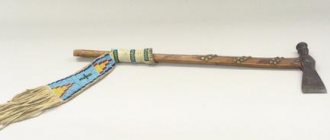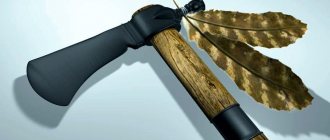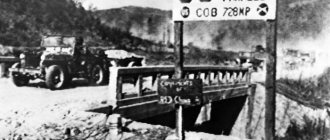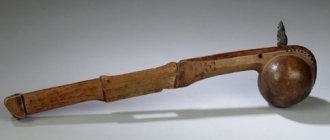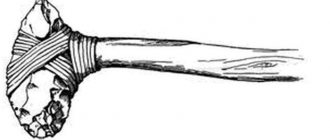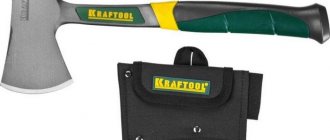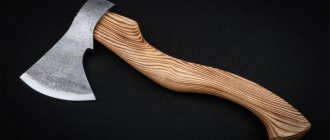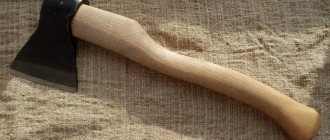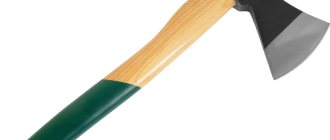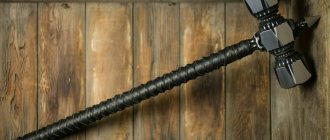Everything new is well forgotten old. The same applies to a tactical ax, or, as it is also popularly called, a tomahawk. The demand for this type of weapon has increased significantly. Some choose it following fashion trends, while others care about the method of application and advantages. Aspects of using a tomahawk hatchet are diverse, from everyday purposes to combat missions.
Tomahawk axe.
History of appearance
Despite the established belief that iron hatchets are the original weapons of the indigenous Indians, this is not the case. Before the discovery of the New World, the natives of America did not know how to process iron, so they used designs and technologies inherited from their ancestors - tools made of stone and wood.
Indian use
Before the advent of the first European explorers, the indigenous population of America used exclusively stone axes - tomahigen. These formidable weapons were more like a club and could be used not only as a combat attribute, but also for domestic and agricultural needs. However, a weapon made from a piece of stone, sharpened on both sides and mounted on a long wooden handle, was unreliable and often broke, since flexible and thin branches were often used for the shaft.
Having seen iron hatchets among the first settlers, the Indians immediately became interested in effective tools made of metal and wood. After all, such an ax had a powerful cutting blow, unlike its stone counterparts. Therefore, whenever possible, the aborigines tried to exchange furs, as well as other products in demand among Europeans, for combat attributes.
Fact. The rapid spread of European strangers and intertribal wars allowed the indigenous population to quickly improve their skills in using hatchets.
The first tomahawks
Weapons with an iron ax instantly became a hot commodity in exchange between Europeans and Indians. The first tomahawks that came to the aborigines can be considered the British boarding axes, which sailed along with sailors from Europe. And if for sailors it was an ordinary tool of labor, then the indigenous people of America perceived it as something amazing. After all, such a tool could easily cut down a tree. Throwing it at a decent distance, stop a running animal or an attacking enemy.
Subsequently, thanks to increasing demand, the holds of ships began to be specially loaded with iron objects and, in particular, battle axes. To accommodate more goods, the axes were folded without handles.
The Indians quickly learned to use this functional and versatile weapon for domestic and combat purposes. Europeans' fighting tools helped them in hunting, in war, and in defending their home. They could be used in long-distance throwing and close combat. But at the same time, they were excellent for cutting down trees, digging and cutting up the carcasses of killed animals.
Peace Tubes
Later, some axes received another use. A hole was drilled in the handle, and a special cup for tobacco was installed in the butt. The production of smoking pipes was most often carried out by Europeans (the British and French), and later by the Americans. A wooden or metal inlaid mouthpiece, decorated with carvings, a cup made of a brass shell, but at the same time a formidable military weapon that could be instantly transformed. Such pipes had no religious significance for the Indians, however, they could be used in various rituals or ceremonies.
Hatchets, richly decorated with carvings and ornaments, most often served as a symbol of peace in negotiations between various tribes or Europeans and aborigines. The Peace Pipe was lit and passed around to each participant in the negotiations. This symbolized reconciliation or the end of hostilities.
Fact. The tomahawk pipe was rightfully considered one of the richest gifts to tribal leaders. Carvings, engravings and various decorations gave it great value in the eyes of the Indians.
Missouri tomahawks
Along the banks of Missouri, military axes were very popular, differing in style from the general mass of products of this type brought to America. Such axes had a thin, long blade of the cutting part, turning into a simple butt with a rounded eye, and a handle of about 35 centimeters or more. Trying to make the cheapest tools possible, craftsmen abandoned metal hardening. Most often, just a strip of metal was used for the blade, without sharpening.
The large surface area of the blade made it possible to decorate it with a wide variety of patterns, made in the form of engravings or figured slots, which was greatly valued by the Indians. That is why these products were used exclusively for military or ceremonial purposes. Their use in everyday life was considered impractical.
Missouri tomahawks
Espontone battle axes
The name "espontonic" comes from the English word "spontoon". The officers of the European military were supplied with the weapon of the same name. The hatchets had a distinctive detail - twisted appendages at the base of the blade. Moreover, the bend could be completely different. Sometimes these parts were slightly curved or had an almost straight line. Often they could be bent into rings or semicircles. The cutting part of some types could be made of brass.
Espontone axes could be tubular, have an additional point on the butt, and also, quite rarely, a second blade made in the form of a blade. In some areas there were items very reminiscent of Celtic weapons. The blades of such axes could be diamond-shaped and have holes of the same shape.
Most often, espontons were supplied by the French, who knew very well the attitude of the aborigines to decorations and carvings on military attributes, and, of course, took advantage of this in the exchange of goods.
Tomahawk battle ax
Trade tomahawks
An example of the cheapest and easiest to manufacture Indian axes are trade axes. Most often, they served as an item of exchange for fur goods, which gave the axes their corresponding name.
Due to their small size, they were often called half-axes. The blade could be flat or rounded and turned into a simple butt. A fairly popular variety were axes with double-sided blades. Some repeated the shape of a lumberjack's tool. The wooden handle on such products could be attached both from below and from above the hole in the ax handle.
European countries, in particular England, Holland and France, produced and supplied trade tomahawks to the aborigines in large quantities. Typically, these tools were used for domestic and agricultural needs, but if necessary they could serve as military weapons.
Interesting. It is believed that in everyday life, trade axes were often used by women. This is how the name “axe squaw” came about.
Tomahawk: history of the name
Indian battle ax
I think that many will agree with me, if you ask anyone you meet about the tomahawk axe, the answer will be an Indian axe . Take, for example, even that same story from school or films about Indians. But let's look at our ax in more detail.
Translated from English “tomahawk” is where the name of the ax comes from. In the Indian translation, twisting the English pronunciation, it turned out “tamahakan” - something that is used to cut.
At a time when Columbus had not yet discovered America, among the Indians this word meant “an elongated stone, sharpened at both ends and mounted on a wooden handle” and looked completely different from how we are used to seeing them in those very films. And only after the discovery of America, the word tomahawk meant a metal ax .
How and what were tomahawks made from?
The first axes that came to the Indians were made with European care. A steel blade was used for the cutting part, the handle was made of durable wood. In the process of developing trade relations with the aborigines, they began to receive weapons made from a sheet of ordinary metal, without sharpening and often without a handle, since this was how much more items could be placed in the hold of a ship.
The blades of the Indian hatchet could have a wide variety of shapes and were made from:
- become;
- bronze;
- brass;
- gland.
The handle was most often made from 50 to 60 centimeters. In rare cases, the length of the shaft could exceed 60 centimeters. Most often, hardwood was selected for it - ash, maple and hickory.
One piece tomahawk
Tactical M48
The chopping part in a product such as the M48 Hawk tomahawk ax is made of 440c stainless steel, which is subject to further processing in the factory in the form of applying a black coating to it.
The length of the hatchet is 39 cm, the length of the blade is 95 mm, the thickness is 2 cm. The handle of the M 48 Hawk tomahawk is a reinforced polypropylene product, to which the chopping part is attached using power bolts and a steel rim that enhances the stability of the blade. The length of the handle is 34 cm. The tactical hatchet weighs 910 grams. A special nylon sheath is included in the kit.
Design and manufacturing features
When they got to the aborigines in exchange for furs and other products, ordinary axes were sometimes changed beyond recognition. A deep modernization of weapons was carried out in accordance with the new owners’ idea of beauty and convenience.
Usually the wide cutting part of the blade was ground off, thus significantly reducing the weight. This was necessary because the tomahawk was often used to throw over long distances. The butt also changed. It lengthened and turned into a beak-shaped protrusion (beak), which could be used to deliver targeted blows.
The handle, butt and canvas were covered with carvings, as well as a wide variety of ornaments, depending on the area in which the ax fell and the beliefs of the Indians. After all, a secret meaning was invested in engraving and painting, expressed in symbols and drawings. This, as the aborigines believed, was supposed to help them in battle and hunting.
Talismans and amulets were attached to weapons to protect against evil spirits. They could be used as scalps of killed enemies, fangs of predators, bird feathers and other objects considered sacred.
About the nature of the damage caused by the Indian ax
Excavations studied by archaeologists in the territories of Indian settlements indicate that the skull, collarbone, ribs and left forearm bone are most susceptible to injury from tomahawks. Based on the nature of the damage to the skull of the examined corpses of soldiers who died from a tomahawk, it was believed that the blows with an ax were applied from top to bottom along an arcuate trajectory. Damage to the collarbone was apparently caused in cases where a slashing blow to the head did not reach its target. Injuries to the left or right forearm were less common. In all likelihood, they could have been produced while the person was covering his head. The second technique used by warriors of that time was an arcing slash to the body. It was applied along a horizontal trajectory. In such cases, the ribs were damaged.
Tomahawk production technology
To forge an ax, special skills were required: a forge with a forge, an anvil and other accessories. But before that, it was necessary to extract ore and then smelt iron from it. Therefore, most often the production of Indian hatchets in America was carried out by visiting European settlers. They built forges and were engaged in the manufacture or repair of metal objects and military equipment.
The Aborigines began to master blacksmithing only at the end of the eighteenth - early nineteenth centuries. However, most often they used scrap - unnecessary iron products left behind by Europeans, rather than ore.
Is it possible to make a tomahawk with your own hands? Of course, it is possible, however, this will require some skill and the necessary materials.
Production process:
- the wood for the handle must be well dried, otherwise the heavy iron part may fly off during use of the product;
- for the ax handle, a rectangle of suitable size is forged, in which a hole is made for the eye;
- a special forging hammer is used to give the blade the required shape;
- the workpiece should be hardened;
- the ax handle is mounted on the shaft and wedged with a wooden wedge;
- if necessary, the cutting part is sharpened.
Fact. Usually only the blade is subjected to hardening, but the butt is not processed.
Polishing the handle, inlaying, engraving and decoration was a separate, very important part of the work, which was given almost sacred significance. Moreover, both the Indians themselves and their shamans could do this, depending on the importance of the item being produced.
Tomahawk throwing
Tomahawk decorations
Decorations on the tomahawk
If we recall any movie or book we read about the Indians, the tomahawk we saw in most cases did not look like a simple battle ax, but some attribute of decoration was always present on it.
I would like to remind you that most tomahawks were supplied from Europe, and the suppliers only delivered the blades themselves, since the ax and shaft took up a lot of space during delivery. Based on this, many Indians themselves made handles for the blade, while decorating them with all kinds of decorations.
Everything was used: feathers, pieces of fur, beads, porcupine quills, hair and even scalps from a person’s head. The shafts themselves were often simply polished, burned or cut out with all sorts of patterns, painted, and the handle was wrapped in fabric, animal skin, or thin wire.
The Indians could not do anything on the blades themselves, since they did not know blacksmithing. They mastered this skill only at the beginning of the 19th century, but seeing how difficult it was to mine ore and smelt metal, they decided to return to exchanging for food or jewelry.
Many suppliers took advantage of this and began to produce blades for every taste of the Indians. Blades began to be made from many types of metal, various engravings were applied, and inlaid with gold and silver. Many tomahawks were made as gifts and could not be used as weapons.
Application in wars and conflicts
Having fallen into the hands of the aborigines, the tomahawk immediately finds itself involved in numerous military clashes. These include internecine wars between tribes and military clashes with regular forces.
During the American Revolutionary War, the Indian hatchet became indispensable because it was effective in close combat and could also hit a target at a distance. Thanks to him, in hand-to-hand combat, Indians and militiamen often won victories over infantrymen armed with carbines.
Characteristics and similarities of the tomahawk
The tomahawk is very similar to other axes
The ax blade itself has many shapes in similarity, resembling different axes from different eras or in the form of a spear tip, but lying perpendicular to the shaft. On the other hand, the butt also has several shapes, reminiscent in appearance of other axes, such as klevets , due to the fact that it had a hammer-shaped butt or a hammer with a pin on the butt, square and round in cross-section.
But there was also a model of an ax that looked exactly like a small halberd . Due to its functionality, the ax was used both for combat and for hunting or everyday life, for example, cutting down trees. The Indians used such an ax only in close combat and it was thrown at the enemy very rarely.
Ax throwing was done to improve mastery of an ax and was thrown as a sports equipment in training. The functionality of the battle ax allowed the blade to be removed from the shaft and used as a knife. Such an ax weighed approximately 500 - 600 grams, the length of the cutting edge of the blade varied from 80 to 100 mm, and the straight shaft was from 300 to 550 mm long.
The nature of the appearance of the tomahawk
Since the Indians themselves could not make metal axes, they traded them with the settlers who settled in their area at the beginning of the 17th century for furs or jewelry. Battle axes were also imported from Europe and they were already steel and improved battle axes of the British Marines, who used axes when boarding ships.
The tomahawks produced in Spain differed from the English ones in that they had a wide, moon-shaped, rounded blade. The French living in Canada were the first to make a tomahawk in the form of a tomahawk (the blade is shaped like a beak and the butt is shaped like a hammer).
Read on "E-KLAD": In search of gold
Tomahawk - a formidable weapon of the Indian
Tomahawk - a formidable weapon of the Indian
By exchanging tomahawks for food, the Indians appreciated the ax and turned it into a formidable weapon. By exchanging axes with settlers, the Indians repeatedly learned the technique of using an ax and surpassed their teachers many times over.
The trained Indians surpassed their teachers in close combat, and in throwing they had no equal, since every time a thrown ax hit the target at a distance of up to 20 meters! When using bows, knives and spears in battles, the Indians appreciated the superiority of the tomahawk.
The functionality of the ax allowed even a weak person to use it due to the lever handle. He could cut off a limb or cause a very large wound. The weight and length of the tomahawk allowed them to operate both in the thick of battles and in one-on-one combat. Plus, they used an ax to finish off a wounded animal.
Disadvantages of modern models
Modern battle hatchets can be divided into groups:
- identical;
- with plastic handle;
- whole.
Identical axes are weapons made similarly to the real one, with a forged ax handle and a wooden shaft. They are distinguished by a simple design, as well as good balancing, which allows the ax to be used both in close combat and for throwing.
Axes with a plastic handle have many disadvantages. The handle can rotate during impact and break during everyday use. And poor balance makes them unsuitable for throwing.
The good thing about solid hatchets is that they cannot be broken. However, due to their light weight, they are incapable of a piercing effect, so they can rather be called a blade shaped like a lumberjack's tool.
What is a tomahawk for?
The tactical tomahawk has a number of advantages that help solve various types of problems:
- small size and lightness;
- a structure made entirely of metal is much more reliable;
- convenient for concealed carry.
These properties apply to:
- cutting small trees, bushes, branches, splitting firewood;
- ax throwing at a distance (all-around);
- removal of rubble at the site of collapsed buildings;
- climbing trees, brick and stone walls.
Safety
Self-defense and safety are the first things this ax guarantees. Therefore, it is one of the attributes of army equipment as a melee weapon. Better than a bayonet in cases where shooting with a rifle is undesirable or impossible. It wouldn’t do any harm for a common man to acquire such bladed weapons either.
Melee tomahawk.
Hunting
Hunting lovers will appreciate the accessory. Practice should begin with throwing at trees and other stationary objects.
Ax throwing training.
Fire
If one's own survival is at stake, then the production of fire as a source of heat and energy comes to the fore. To light it, you will need firewood. A tomahawk will come in handy.
Handmade tomahawk.
Construction
An indispensable tool during hiking trips or unforeseen circumstances when it is necessary to build a shelter.
Tomahawk.
Types of fighting Indian tomahawks
- Earless
The ax handle did not have a hole for attaching the shaft, and was hammered or inserted with the pointed part of the butt into the handle. This type is part of the Celtic ax group and is one of the first Aboriginal tools.
- Ears
They were a classic type of hatchet, with an eye into which the handle was inserted. These are the tools that sailors brought to America.
- Halberds
Axes identical to the halberd, but with a shorter shaft. Most often they participated in the exchange of goods between Europeans and Indians. The handle was attached using cone-shaped bushings.
- Other
It is impossible not to mention the convenient war hammers, used not only by the aborigines, but also by settlers as belt weapons. Derivatives of boarding axes, having hooks or sharp lances on the butt. Clubs made of deer antler with a tip made from any available materials. All this, in fact, can also be attributed to Indian hatchets. Because, despite the most diverse forms, all these tools had common features and the same application.
Halberd tomahawks
Varieties of the Indian tomahawk ax
As already mentioned, the tomahawk is used in different life situations. Therefore, for each type of work it is more correct to choose a specific type of such ax. Famous brands are undoubtedly high quality, but at the same time the corresponding high cost. In addition to them, there are types of tomahawks at an affordable price and of equally good quality.
Tactical SOG F01TN-CP
SOG F01TN-CP
A budget option that can be used to perform auxiliary operations: removing obstacles, breaking doors, excavating soil, and also during hunting.
Dimensions: total weight – 700g, total length – 40 cm.
Characteristics:
- The handle is made of thermoplastic - a lightweight, durable material that is resistant to high temperatures and chemicals, impact-resistant, and does not conduct electricity.
- The head is made of stainless steel.
"Canteen" M48 Ranger Hawk Ax
M48 Ranger Hawk Axe.
The American-made tomahawk is a multi-functional tool that can be used to chop and cut, and also helps to overcome obstacles. This is a whole set of items, which, in addition to the tomahawk, includes a rope (sling), a carabiner, a compass and a case.
Dimensions: total length – 40 cm, total weight – 600 g.
Characteristics:
- Fiberglass reinforced nylon handle. The end of the handle is wrapped with a black lanyard, which is threaded through a hole in the tail and held in place by a climbing carabiner.
- There are three bolts on the ax handle for fixing it to the head.
- In addition to the axe, in the upper part there is a continuation in the form of the tip of a pickaxe.
- The blade is made of stainless steel.
Browning Shock N' Awe
Designed to perform many different functions, also for self-defense purposes.
Dimensions: total length – 27 cm, weight – 670 g.
Tomahawk Shock and Awe.
Characteristics:
- The shape resembles a hammer.
- All-metal carbon steel tomahawk.
- Brown color.
- The handle is wrapped in a brown polymer cord, the end of which is threaded into a hole at the end of the axe.
Gerber Downrange Tomahawk
Gerber Downrange Tomahawk.
Another powerful American instrument of complex design. Allows you to penetrate walls, breaking through them, and destroy obstacles, for example, cutting ropes.
Characteristics:
- A slot in the head of the ax allows you to grab it with your hand and use it as a lever.
- The tail of the ax serves as a claw pry bar, which is used to open hinges and locks on doors.
- Milky fiberglass lining on the handle prevents slipping.
Kangee T-Hawk
Kangee T-Hawk.
Suitable for field work and survival: cutting small trees, firewood.
Dimensions: weight - 700 g, length - 36 cm.
Characteristics:
- Material: steel coated with Teflon powder.
- The tail section is equipped with thermoplastic removable pads. To prevent the ax from slipping in the hand, the linings have a large-cell texture.
Tomahawks in modern times
Nowadays, interest in rather ancient military attributes does not dry out. Just like 200 years ago, tactical hatchets are produced by well-known weapons companies, which not only fully retain the universal functionality of a combat device, but also add some important details.
During all the famous wars of the last century, the Indian ax was necessarily included in the army uniform. And this is not surprising, since it could be used not only during battle. With its help, one could climb a wall, open a can of canned food, cut down trees for camouflage and overnight shelter, knock down a lock and do many other things for which neither a knife nor any other military attribute is suitable.
In peacetime, tactical guns performed well during travel. When going on a trip, tourists are sure to take this universal tool with them.
Tactical weapons
The battle hatchets that American soldiers were equipped with have undergone major modifications in our time. Modern and more improved versions of tomahawks have appeared. Since these products were intended not only to perform combat missions, they began to be called tactical.
Tactical axes and tomahawks were in great demand among American soldiers during Operation Desert Storm. Without a compact and convenient device for breaking doors, the soldiers were forced to carry huge fire axes with them. Tactical hatchets are much lighter and more maneuverable, and besides their main task (cutting), they perform a number of additional functions. They can be used to knock down padlocks, open doors, break glass in cars, etc. In a combat situation, such an ax is considered indispensable, especially when it is undesirable to use firearms. Similar situations may arise if the battle is fought near flammable and explosive substances or toxic chemicals.
Tactical axes and tomahawks are especially popular in the special forces of the United States of America. These models did not take root in the army of the Soviet Union. The USSR military command initially planned to equip personnel with tactical hatchets, but over time they decided that this would be too expensive. An analogue of the American tomahawks in the Red Army was the sapper shovel, which, according to the Soviet leadership, was no worse.
The benefits of artisanal production. What's better than a forged tomahawk?
It is not difficult to make an ax with your own hands. The product will turn out to be of truly high quality, as a classic ax should be, only if it is produced in a forge. In it you can forge both a standard ax, necessary for carpentry work, and a very aesthetic, exclusive tomahawk.
It can be used as a gift, souvenir or interior decoration. In terms of their technical characteristics, forged products are much better than factory cast ones. This is due to the characteristics of the crystal lattice of metals, the structure of which can be changed during forging. As a result, a tomahawk hand-made in a forge with changes in the crystal structure can withstand force and shock loads well, and the blade of such a tomahawk remains sharp for a long time. The service life of hand-forged axes is much longer than that of factory-made axes.
